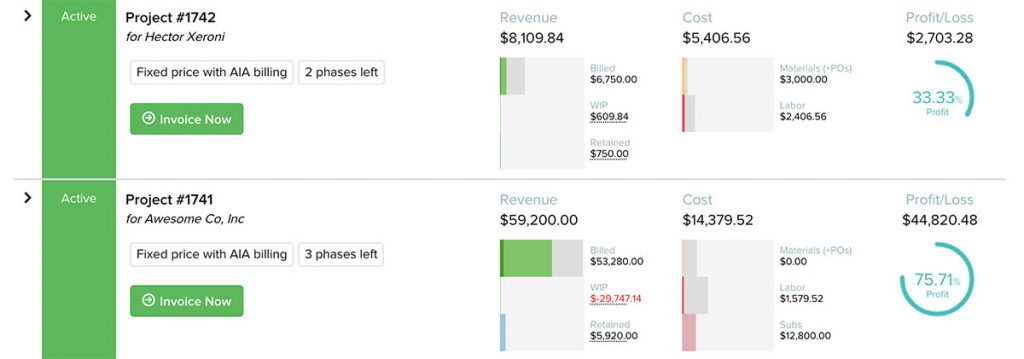What is WIP (work in process)? #
Work In Progress (WIP) is an accounting concept meaning the value of the work you have completed but have not yet invoiced. WIP can be important if you are trying to understand the current profitability of a job, especially if your percent completion of a line item is ahead of or lagging behind the estimated number of labor hours you thought it would take in your budget. WIP reports can also help you manage your cash flow, since they give you a sense of what your billings are likely to be at the end of the month, which is vital for keeping a gauge on financial health.
Also known as: Work in Process, Unbilled work
Use of WIP reporting in construction #
Here is an example of how WIP is calculated in the construction industry. One of the line items on a contract is worth $10,000. The budget for the labor portion of that line item is $5,000. The contractor has not billed for the line item yet, but has already spent $2,000 in labor costs on the item, and is on schedule (about 40% complete). The contractor thus has $4,000 in Work in Progress.
They have legally earned $4,000, given that they have completed 40% of the work; they just have not invoiced it yet. So, when the run their profitability reports, they should see $4,000 in earned (unbilled) revenue for that line item.
Thankfully, the days of manually calculating WIP are over. Knowify’s suite of construction management tools enables contractors to track progress, and expenditures, monitor time, generate professional invoices, and develop reports to stay on top of every project. All combined, you’ll have a centralized tool to access everything you need to generate WIP reports quickly and efficiently.
See how WIP works in Knowify:

Why is WIP important? #
A WIP report will show a contractor whether they have overbilled or underbilled for any given project. For this reason alone, the WIP report is an essential financial tool for contractors. However, WIP reports can also be used by construction companies to uncover detailed insights that contractors should take advantage of. Consider external financial institutions- whether it’s a banker, lender, or project owner, there is always financial risk involved for other parties. If actual costs and progress start to skew off course, these parties will have a strong interest in keeping up to date on the financial performance of construction projects. A reliable way to do so is to refer to the WIP report.
For this same reason, contractors can rely on WIP reports to accurately determine where they stand during the entire course of a project. For example, you are underbilled if you have completed 75% of a project phase but have only billed your customer for 50%. Underbilling can cause a multitude of cashflow issues that can leave contractors strapped for cash that can prevent you from getting the materials needed to work on other projects, pay your team, or finish the project at-hand.
Underbilling can also cause reported revenue to artificially inflate. The reason why? Underbilling is seen as assets on a balance sheet because they represent future revenue to be billed for work that you have already completed. For this reason, any underbilling should fall into your asset account for financial reporting.
On the other hand, if 75% of a phase has been billed, but you have only completed 50% of the phase thus far, you are overbilled. Overbilling will be recorded as a liability since you are still on the hook for work that still needs to be completed. There is a tendency to overbill to mitigate cashflow issues and gain the cash necessary for a project upfront. Excessive overbilling, however, can result in overinflated financial performance, i.e., contractors will think they have cash sitting in the bank that isn’t actually there. This can create a scenario where that same contractor will then use that non-existent cash on another project, or materials, resulting in financial headaches down the line. For these reasons, frequently referencing a WIP report is crucial for contractors to effectively manage cash flow and accurately gauge profitability.
WIP reporting in Knowify #
Knowify offers Work in Progress reporting so that you can see which jobs need to be billed, and to ensure that you do not get a false view of your current profitability owing to the quirks of invoice timing.
To learn more about Work in Progress, read our latest blog: Construction work in progress: Everything you need to know about WIP.